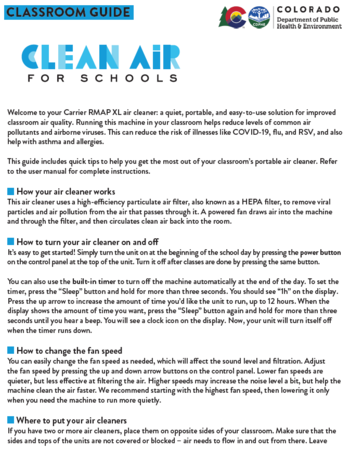Clean Air for Schools
Available languages: Español

The Colorado Department of Public Health and Environment’s (CDPHE) Clean Air for Schools program provided free high-efficiency particulate air filter portable air cleaners (HEPA PACs) and associated supplies to K-12 schools and licensed early childhood education (ECE) providers.
The program’s goal is to improve schools’ indoor air quality as a mitigation measure for exposure to respiratory viruses such as COVID-19, flu, and RSV, as well as other pollutants and pathogens that contribute to asthma, allergies, and other chronic respiratory illnesses.
CDPHE contracted with Carrier West, the Colorado-based partner of Carrier Corporation, to distribute HEPA portable air cleaners and associated supplies, such as replacement HEPA filters, to schools throughout Colorado. Through a partnership with the University of Colorado Boulder, certain participating K-12 schools also had the opportunity to receive indoor air quality monitoring systems at no cost. Learn more about the air monitoring program at the University of Colorado Boulder’s Clean Air for Schools webpage.
Resources for participating schools
Room Air Purifier XL technical manuals
- Quick start guide
- Troubleshooting guide
- Filter replacement guide
- User manual
- Limited warranty card
- For additional warranty support, call Carrier West at 303-563-3082.
American Lung Association resources
Clean Air at School
The American Lung Association offers tools and resources for learning about indoor air quality in the school setting.
Indoor air quality activities for kids
The American Lung Association created activities and lessons for teachers and caregivers of children pre-K through middle school to teach about indoor air quality concepts in a fun, engaging way.
Frequently asked questions about HEPA portable air cleaners
HEPA portable air cleaners combine a powered fan system with a High Efficiency Particulate Air (HEPA) filter, which is at least 99.97% efficient at filtering respiratory droplets and particles that could be carrying COVID-19, influenza, RSV, or other airborne pathogens. HEPA PACs provide a mobile, effective, and efficient option to clean air in spaces where there is risk of viral transmission. In addition to reducing the risk of COVID-19, flu, and RSV, HEPA PACs can be effective at reducing indoor concentrations of other air pollutants that can contribute to asthma, allergies, and other respiratory health issues, such as wildfire smoke, vehicle emissions, and industrial pollution.
The Clean Air for Schools Monitor Program, a part of the larger Clean Air For Schools Program, is fully funded by the Colorado Department of Public Health and Environment (CDPHE). This part of the program is a partnership with the University of Colorado to provide Attune indoor air quality monitors, complete monitor installation, training, access to a school data dashboard, and a 24-month data subscription at no cost to schools.
The number of monitors installed depends on the number of classrooms and students at each participating school.
Indoor air quality monitors were installed in selected classrooms around the school. The selected Attune monitors measure indoor temperature and humidity levels as well as concentrations of several common markers of air quality, including carbon dioxide (CO2), particulate matter (PM), and volatile organic compounds (VOCs).
The data from each monitor will be sent through the school’s wireless network to a central hub/server. School personnel can access indoor air quality data from a desktop or mobile app in a secure portal. Schools are encouraged to designate at least one person who will be responsible for accessing and reviewing the data dashboard. Each school owns the data and controls who has access to it. The data collection, transmission, and reporting is completely secure and does not access or interfere with other school data or electronics.
Schools receiving the indoor air quality monitors will be invited to an online training session with Attune and the University of Colorado Boulder to learn how to use the monitoring system. They are also able to access a pre-recorded training video at their convenience. Additional information and resources are available on the University of Colorado Boulder’s Clean Air for Schools webpage.
No. Schools can look at the data in the app to help inform if there is a need to manage their HVAC operation, open windows, increase filtration, etc. CDPHE will not track if schools are looking at or using the data for facility management. Schools can choose to be as involved as they would like with their IAQ data. They can choose to simply monitor air quality, but can also use data to inform facilities’ maintenance priorities.
The indoor air quality monitors and monitoring data are provided at no cost to schools for 24 months (two years). After the initial 24 months, schools will still own the monitors, but the subscription to maintain the data logging platforms will expire. Schools may continue to use the monitors with a paid data service after this time.
Should the school decide to phase the monitors out of use, once the data subscription is no longer active, the units will stop working and will not continue to make measurements or collect any data. Schools will be able to download data from the two years’ of monitoring if they choose. The school can leave the units in place, in case they would like to reactivate the subscription in the future, or they can remove the units. The physical units will remain the property of the school.
This program is supported by Centers for Disease Control and Prevention (CDC) of the U.S. Department of Health and Human Services (HHS) as part of an award totaling $173,450,305 with 0% percentage financed with non-governmental sources. The contents are those of the author(s) and do not necessarily represent the official views of, nor an endorsement, by CDC, HHS, or the U.S. Government.

